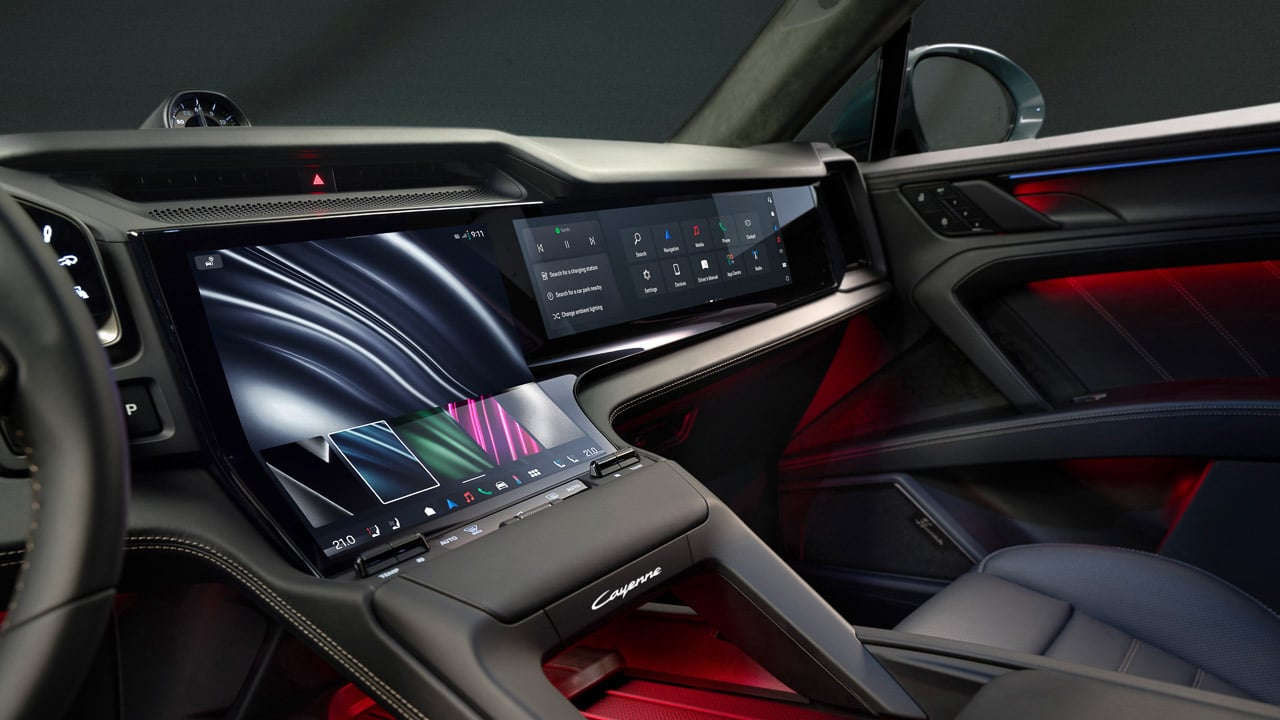Porsche revealed the interior of its upcoming electric Cayenne on September 30, 2025, and I’m experiencing the kind of cognitive dissonance that only comes from loving something I fundamentally disagree with. The cabin features what the company calls the largest continuous digital surface in any Porsche to date. Translation: screens everywhere. As someone who prefers minimal dashboard clutter, I should hate this. But Porsche’s execution here is genuinely impressive, even if it represents everything wrong with modern automotive design philosophy.

Designer: Porsche
Let me be clear about my bias upfront. After reviewing vehicles for over a decade, I’ve developed a strong preference for physical controls. Give me a rotary dial for volume, actual buttons for climate control, and a small display for Apple CarPlay. That’s all I need. Everything else just creates more opportunities for distraction and frustration. The industry’s obsession with touchscreens has turned dashboards into iPad showrooms, and I’m tired of it. But then Porsche goes and creates something like this.
Three Layers of Interaction
Porsche’s approach to the Cayenne Electric interior centers on what I’d describe as three distinct interaction layers. First, there’s the glance layer: a 14.25-inch curved OLED instrument cluster that bends horizontally to favor the driver’s sightline, paired with an optional augmented-reality head-up display. This is information you consume without touching anything.
Second is the touch layer, anchored by what Porsche calls the Flow Display. This is where the interface design gets genuinely interesting, and where my skepticism starts to crack.

Third is the tactile layer: physical buttons for key functions that you use most frequently while driving. Temperature, fan speed, volume. The stuff that should never require diving through touchscreen menus when you’re moving at highway speeds.
This three-layer framework represents Porsche trying to reconcile driver focus with customer demand for integrated entertainment. Rather than creating a single wall of glass like some competitors, the brand is using curvature, AR guidance, and selective hard controls to maintain some connection to traditional cockpit ergonomics.
The Flow Display
Porsche’s Flow Display is the center of the Cayenne Electric’s interior story. It’s a curved OLED that drops from the dashboard toward the console, so your wrist meets the glass at a natural angle rather than an upright plane. The curve is functional for reach and for stabilizing taps on the lower interface zones. Directly ahead, the 14.25-inch curved OLED cluster bends along a different axis to favor the driver’s sightline, which keeps EV power, navigation, and assistance info legible at a glance.

Together they make the largest continuous digital surface Porsche has put in a production cabin, but the company still leaves physical buttons for key functions to reduce menu diving in motion. Five predefined color schemes can be applied across the cluster, Flow Display, and passenger screen through a Themes App, turning the software layer into part of the cabin’s material palette.
I’ve seen plenty of curved displays in vehicles over the years, from the Mercedes-Benz S-Class to the Cadillac Escalade. Most feel gimmicky, like the design team added curves just because they could. The Flow Display’s vertical curve actually serves a purpose. After years of stretching to tap screens in various test vehicles, I appreciate the thought behind meeting my fingers at a more comfortable angle. It’s a subtle detail, but one that suggests actual human factors testing rather than pure aesthetics.
The Themes App detail is worth noting because it shows Porsche treating digital surfaces as coordinated design elements rather than isolated screens. You’re not just picking a wallpaper. You’re establishing a visual language across the entire dashboard that integrates with your interior trim choices. For a brand that obsesses over material quality and color matching, this makes more sense than I’d like to admit.
When Two Screens Aren’t Enough
An optional 14.9-inch passenger display lets the right seat control media, apps, and navigation features, with video playback allowed while driving. Porsche says the setup avoids distracting the driver, and several reports add that a polarized layer limits visibility from the driver’s angle. Keep it for road trips and copilots who actually manage routes, otherwise it risks duplicating what phones already do better.

My personal preference would be to use my phone for entertainment content. It’s already configured with my accounts, my preferences, my content libraries. Why do I need a separate infotainment ecosystem that inevitably provides a worse user experience? But I recognize that many people want more integration, more seamless connectivity between their vehicle and their digital life. That’s the market speaking, and manufacturers are listening.
The augmented-reality head-up display projects guidance and speed into the driver’s forward view with an effective size of 8.7 inches. Use it if you like arrows on the road ahead. If you don’t, the curved cluster is already doing the glance work. I’ve used HUDs in countless vehicles, and my opinion on them remains unchanged. Some people swear by them. I find them distracting and unnecessary, one more piece of visual information competing for attention when you should be watching the road.
The Screen Debate
Stephan Durach, BMW’s Senior Vice President for UI/UX Development, recently told BMW Blog that passenger screens are in high demand, especially in larger vehicles. “People are asking for that,” he explained. “People say, ‘I want to have a dedicated screen for consuming content.’ There is room. So, you can think about that.”

I understand the appeal from a product planning perspective. American buyers love options and choices. If some customers want passenger entertainment systems, why not offer them? The counterargument is that just because people ask for something doesn’t mean it’s a good idea. We’re increasingly treating vehicles like mobile living rooms, with every occupant consuming their own content through their own screen. At some point, we’ve lost the plot on what cars are actually for.
What Porsche Isn’t Saying Yet
The interior recently revealed focused on the digital interface rather than full performance specifications. Porsche hasn’t disclosed final power output, acceleration figures, or detailed battery specifications in this announcement. Those details will presumably arrive with the world premiere at the end of 2025.
What we do know is that Porsche will offer an 11-kW wireless charging pad, launching first in Europe in 2026 before expanding to other markets. I’ve tested wireless charging systems in a few vehicles, and while the convenience factor is undeniable, the efficiency loss compared to wired charging makes me question the value proposition. You’re paying more for the privilege of slower, less efficient charging, though the 11-kW capability is reasonably competitive for inductive systems.
Standard air suspension comes on all models, with optional rear-wheel steering that reduces the turning circle. That’s genuinely useful in a vehicle this size, making parking lot maneuvering significantly easier. The Active Ride system from the Panamera and Taycan will also be available, providing impressive body control and ride comfort.
The Electric Cayenne in Context
Porsche’s commitment to keeping the combustion-powered Cayenne well into the next decade reveals something important about EV adoption. The market isn’t progressing as quickly as manufacturers hoped a few years ago. Rather than forcing a full electric transition, Porsche is hedging its bets by offering both powertrains simultaneously. The same strategy applies to the Macan, where the electric version will coexist with a new gasoline-powered model arriving in 2028.
This pragmatic approach makes sense given current market realities. Some buyers want electric. Many don’t, at least not yet. Offering both options maximizes potential sales while giving the charging infrastructure more time to mature. The Cayenne Electric represents Porsche’s best effort at making EVs appealing to luxury SUV buyers who might otherwise stick with traditional engines.
As for the interior’s screen situation, it’s simultaneously the most impressive and most excessive I’ve seen from Porsche. The execution is genuinely impressive, with thoughtful ergonomics and quality OLED displays. The three-layer interaction model shows more restraint than a pure touchscreen approach, and the Flow Display’s vertical curve actually solves reach and tap accuracy problems rather than just looking different.
But I can’t shake the feeling that we’ve collectively normalized maximum complexity when minimum would serve most people better. Porsche is doing this well because customers are demanding integrated entertainment and the brand is responding with curvature, selective physical controls, and coordinated design language. That doesn’t mean it’s the right direction, just that it’s the direction the market is pushing everyone.
The world premiere happens at the end of 2025, with deliveries expected to begin in 2026. Porsche hasn’t announced pricing yet, but expect a significant premium over the gasoline model. You’re paying for advanced electric powertrain technology, the largest continuous digital surface in any Porsche, and apparently, enough screens to satisfy the most demanding copilots.
The post The Porsche Cayenne Electric Wants You to Forget Physical Buttons Exist first appeared on Yanko Design.
![]()
![]()
![]()
![]()
![]()
![]()
![]()




